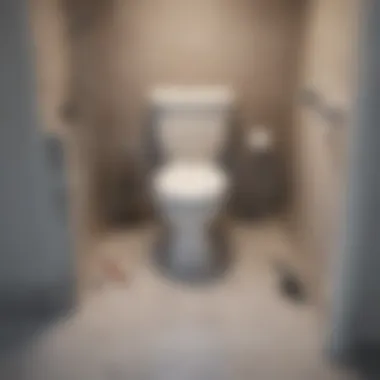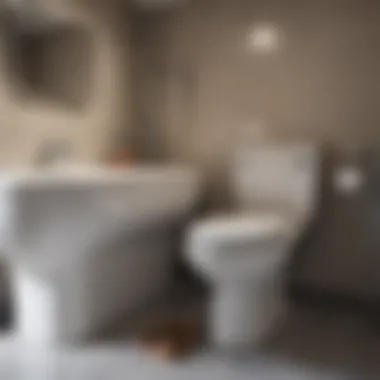Toilet Clogs: Understanding Their Impact on Bathtub Issues


Intro
In every home, plumbing systems play an essential role. They ensure water flows smoothly to where it's needed and that waste is effectively disposed of. However, when issues arise, such as toilet clogs, they can have cascading effects. This article aims to delve into the relationship between toilet clogs and subsequent bathtub problems. By understanding how these systems interconnect, homeowners can mitigate risks, prevent issues, and know when to seek professional advice.
The Interconnected Nature of Plumbing
The plumbing system in a house is a complex network. Toilets and bathtubs usually share the same drainage system. Thus, when a clog forms in the toilet, it can create pressure and lead to water backing up in the bathtub. Understanding this relationship is crucial. It allows homeowners to appreciate that resolving one plumbing issue can impact others.
A single clog can sometimes cause multiple problems in a home's plumbing system.
Causes of Toilet Clogs
To prevent bathtub issues stemming from toilet clogs, one must first understand the root causes. There are several common factors that contribute to clogs:
- Excessive toilet paper use: Flushing large amounts of toilet paper can restrict water flow.
- Foreign objects: Items like toys or hygiene products may accidentally get flushed, leading to blockages.
- Tree roots: In older homes, tree roots may invade sewer lines, causing blockages.
- Hard water buildup: Mineral deposits can accumulate and narrow pipes over time.
Identifying these issues requires vigilance from homeowners. Regular maintenance and awareness of what gets flushed can help in minimizing risks.
Preventive Methods
Preventing clogs from forming is largely about proactive measures. Here are some suggestions:
- Mindful Flushing: Only flush toilet paper and bodily waste.
- Regular Inspections: Check for signs of slow drainage or unusual odors.
- Maintenance Products: Use enzyme-based drain cleaners occasionally to break down buildup.
- Professional Inspections: Schedule regular plumbing check-ups to identify potential issues.
Understanding and implementing these methods can drastically reduce the risk of experiencing bathtub plumbing issues related to toilet clogs.
Finale
Preamble to Household Drainage Systems
Household drainage systems are vital for maintaining the functionality of a modern home. They ensure the efficient removal of wastewater from various fixtures, minimizing the impact of plumbing issues. Understanding these systems allows homeowners to address problems proactively, reducing risk of serious damage. This knowledge can save time and money.
Overview of Plumbing Systems
Plumbing systems in a home typically consist of two main sections: the water supply system and the drainage system. The water supply is responsible for bringing fresh water in, while the drainage system removes wastewater. A well-designed plumbing system uses gravity and careful layout to facilitate flow.
The drainage system includes pipes, traps, and vents. Each pipe in the system has a specific purpose. For example, the traps keep unwanted odors from entering the home and allow air pressure to balance, helping water flow smoothly.
How Water Flows in a Home
Water flows through a home's plumbing system in a specific, organized manner. Fresh water enters through the supply lines. This water travels to various fixtures like sinks, toilets, and bathtubs. After being used, wastewater drains through the pipes leading to the main sewer line.
A key aspect of this system is the slope of the drainage pipes. Pipes should decline slightly to allow gravity to facilitate flow. If pipes are not properly sloped, water may not exit efficiently, leading to clogs.
By understanding how water flows, homeowners can better appreciate the interconnectedness of their plumbing. For instance, if a toilet develops a clog, it could potentially impact the bathtub, given they often share the same drainage system. Recognizing these connections is crucial in maintaining household plumbing efficiency.
Understanding Toilet Clogs
Understanding toilet clogs is essential for comprehending how they can affect other areas of a home's plumbing system. Households rely on effective drainage, and toilets play a pivotal role in this. When a clog occurs, it can create a ripple effect, leading to additional issues elsewhere, particularly in bathtubs, which share drainage systems. Thus, recognizing the signs, causes, and implications of toilet clogs is paramount for homeowners.
The benefits of knowing about toilet clogs include:
- Preventative measures: Understanding toilet clogs helps homeowners take proactive steps to prevent them.
- Cost-effectiveness: Identifying potential issues early can save money on repairs down the line.
- Enhanced hygiene: Frequent clogs can lead to unsanitary conditions. Recognizing them early supports cleanliness.
Common Causes of Toilet Clogs


Toilet clogs often arise from a mixture of everyday habits and maintenance oversight. Some of the most common causes include:
- Excessive toilet paper: Users often underestimate how much toilet paper is appropriate. An overabundance can cause blockages.
- Foreign objects: Items not intended for toilets can accidentally end up in the bowl, creating clogs. This includes things like toys, wipes, or feminine hygiene products.
- Low water levels in the toilet tank: When the tank does not fill appropriately, it may not create enough force to flush waste effectively.
- Build-up of minerals: Over time, mineral deposits can form in pipes, gradually narrowing the flow and contributing to clogs.
- Sewer line issues: A problem in the larger drainage system can also impact toilet function and cause frequent clogs.
Understanding these causes can lead to informed behaviors that mitigate the risk of clogs.
Signs of a Clogged Toilet
Not every toilet clog presents itself in the same manner; however, several signs commonly indicate a problem. Homeowners should be vigilant for:
- Slow draining: Water that drains slowly after flushing is a key indicator of a potential clog.
- Strange sounds: Gurgling noises when flushing or draining can suggest air trapped in the system due to obstruction.
- Unpleasant odors: Foul smells can signify that waste is stuck in the pipes and not draining properly.
- Frequent overflow: Repeated overflow occurrences are a strong sign that the drainage system is compromised.
Identifying these signs early on is crucial. It can help avert more significant complications down the line, including potential bathtub drainage issues.
Being aware of these symptoms allows homeowners to act swiftly, preventing worsened problems.
The Link Between Toilets and Bathtubs
Understanding the connection between toilets and bathtubs is crucial for homeowners. Both fixtures typically share the same drainage system, which means that clogs in one can lead to issues in the other. When toilets become clogged, it can result in water not flowing correctly, which may back up into the bathtub or create other plumbing problems. By grasping this interconnection, one can proactively address potential issues before they escalate, saving time and money.
Shared Drainage Systems
In many homes, the plumbing design incorporates a shared drainage system for toilets and bathtubs. This means that the pipes serving these fixtures are interconnected. Any obstruction or malfunction in the toilet can create pressure imbalances within the entire system.
When the toilet clogs, the water intended to move smoothly through the pipes gets disrupted. Instead of flowing away, it creates a backlog. This can lead to water rising in the bathtub or other fixtures. Understanding this layout emphasizes the importance of maintaining clear drainage paths.
Proper maintenance can prevent the accumulation of debris and enhance system efficiency. Regular inspections and preventative actions are vital for keeping both toilets and bathtubs functioning optimally.
Hydraulic Issues and Backflow
Hydraulic issues often come into play when discussing clogged toilets and their impact on bathtubs. When toilets are clogged, and water can’t exit freely, hydraulic pressure builds in the pipes.
This pressure can sometimes force water back through the system, creating backflow conditions. Backflow not only leads to water rising in unwanted areas but can also introduce contaminants into your bathtub. This is a serious concern as it poses health risks and complicates the plumbing situation further.
To mitigate these risks, homeowners should consider backflow preventers or other such devices that can help manage pressure in drainage systems. Overall, understanding hydraulic dynamics provides insight into the preventive strategies homeowners can utilize to maintain their plumbing integrity and health.
"Addressing clogs early can prevent more extensive plumbing issues and restore harmony in your household drainage systems."
Through awareness of shared drainage systems and hydraulic issues, homeowners can proactively engage in maintenance and care of their toilets and bathtubs.
Exploring Bathtub Clogging Issues
Understanding bathtub clogging issues is crucial for homeowners. Bathrooms are important spaces in the home, and streamlining their functionality is essential for comfort and efficiency. When one part of the drainage system is compromised, it can lead to significant problems elsewhere. Recognizing how toilet clogs relate to bathtub issues allows homeowners to take proactive measures and minimize potential damage.
Bathtub clogs can originate from various sources. Identifying these causes early can save time, money, and stress. Here are some common elements involved in bathtub clogs:
- Hair: Hair tends to be the most prevalent culprit, as it can accumulate in the drain over time, forming a dense mass that blocks water flow.
- Soap Scum: The residue from soap and body products can build up along the walls of the pipes, eventually restricting drainage.
- Objects: Small items, such as toys or shampoo caps, can accidentally slip into the drain and cause blockages.
- Grease and Oils: Although less common in bathtubs than kitchens, lotions or oils can also contribute to slow drainage.
Understanding the interactions between various plumbing components is crucial for efficiently managing the system. Unresolved clogs may not just result in water backup, leading to unpleasant odours and potential water damage. Keeping drains clear is more than an aesthetic concern; it is a maintenance strategy that protects the value of the home.
What Causes Bathtub Clogs?
Several factors contribute to bathtub clogs. One of the primary causes is hair, which can easily collect in the drain over time. This often occurs despite the use of drain covers or filters. Even small amounts can lead to significant blockages when combined with soap scum.
Soap scum accumulation is another key factor in bathtub drainage issues. As soap dissolves, it can leave behind a residue that sticks to the inner walls of the pipes. Over time, this residue can build up and significantly reduce the diameter of the pipe, hindering water flow.
Items like bath toys can inadvertently cause clogs by creating blockages in the drain or trap. It is not always easy to notice them until the drain becomes slow or completely blocked. Occasionally, mineral deposits, particularly in hard water areas, can accumulate within pipes, contributing to clogs.


Symptoms of Bathtub Problems
Recognizing the symptoms of bathtub problems is necessary to take timely action. Common signs of clogged bathtubs include:
- Slow Drainage: Water taking longer than usual to drain is one of the first indicators.
- Gurgling Noises: Sounds from the drain can indicate that water cannot flow freely through the pipes.
- Unpleasant Odours: Foul smells often signal trapped debris within the plumbing.
- Water Backup: If the drain is completely blocked, water may begin to overflow from the tub.
Paying attention to these signs is essential. Homeowners can avoid more serious plumbing issues by addressing them early. Regular maintenance and awareness of drainage systems can prevent minor issues from escalating into larger problems.
Preventative Measures for Clogs
Preventative measures are critical in maintaining the health of household drainage systems. Understanding how to preemptively tackle clogs benefits not only the toilet but also the interconnected plumbing, such as bathtubs. By being proactive, homeowners can avoid expensive repairs and potentially damaging situations.
Proper Usage of Toilets
Using toilets properly is essential to prevent clogs. Several practices should be implemented for smooth operation:
- Limit Paper Use: Avoid using excessive toilet paper. Use a reasonable amount and consider alternatives for hygiene products.
- Educate Household Members: Ensure everyone in the home knows what can and cannot be flushed. Items like wipes, feminine products, and cotton swabs should be disposed of in the trash, not the toilet.
- Regular Inspections: Check for any signs of wear or dysfunction in the toilet. Catching issues early may save from escalation into major clogs.
These practices collectively contribute to reducing the frequency of toilet clogs, thereby ensuring that the bathtub’s drainage system remains functional.
Maintenance Tips for Bathtubs
Bathtubs can also benefit from regular maintenance to prevent clogs. Implementing simple strategies can prevent issues before they arise:
- Clean Drains Regularly: Removing hair and soap residue from the drain minimizes obstructions. A small strainer can catch debris before it goes down the drain.
- Use Enzymatic Cleaners: Consider using enzymatic drain cleaners. They help to break down organic substances and prevent build-up.
- Check for Leaks: Regularly inspect the bathtub plumbing for leaks. Small leaks can indicate larger issues, such as pressure in the pipes, that may lead to clogs.
By maintaining a habit of monitoring and cleaning bathtubs, homeowners can be proactive in keeping their drainage systems clear.
A well-maintained plumbing system not only prolongs the life of fixtures but also ensures overall comfort in the household.
These preventative measures help to reduce the risk of clogs throughout the house, ultimately benefiting both toilets and bathtubs.
DIY Troubleshooting Techniques
Understanding DIY troubleshooting techniques is crucial for any homeowner. This knowledge can empower individuals to tackle plumbing issues without immediately contacting a professional, which can save both time and money. Taking a hands-on approach also helps cultivate a sense of ownership and responsibility towards home maintenance. Knowing the methods of identifying and fixing clogs can prevent minor issues from escalating into major repairs. Moreover, DIY strategies often reinforce practical skills that can be applied in various home maintenance tasks.
A few considerations regarding DIY troubleshooting include understanding your plumbing system, knowing when to stop if the problem persists, and the importance of safety. While it’s beneficial to resolve simple issues independently, tackling more complicated problems can lead to bigger headaches. Thus, each step taken must be carefully evaluated.
Tools You Might Need
When attempting to resolve drainage issues, having the right tools is essential. Here is a list of tools that may be helpful:
- Plunger: A standard household tool for unclogging toilets and sinks. A flange plunger can be particularly effective in toilets.
- Auger: Also known as a plumbing snake, it can navigate through pipes and remove deeper clogs.
- Drain Cleaner: Chemical or enzymatic products can help dissolve minor blockages.
- Bucket: Useful for catching water during repairs or when unclogging.
- Gloves: Safety gloves protect skin while working in unsanitary conditions.
- Flashlight: A bright light aids in seeing through darker spaces in plumbing systems.
Step-by-Step Clog Clearing Process
To effectively clear a clog, follow these steps:
- Assess the Situation: Determine where the clog is located and gather necessary tools.
- Use the Plunger: Start with the plunger. Place it over the toilet bowl drain. Push down gently, then pull up quickly to create suction. Repeat for a few cycles, assessing progress.
- Employ the Auger: If the plunger doesn't work, insert the auger. Feed it into the toilet drain, twisting as it goes. Continue until resistance is felt. Then, crank the handle to break apart the clog.
- Applying Drain Cleaner: If clogs persist, consider a drain cleaner. Follow the instructions closely. Let it sit for the recommended time before flushing.
- Reassess the Situation: After you've attempted to clear the clog, check if water drains properly. If not, it may require further intervention or professional help.
"Regular maintenance and quick responses to early signs of clogs can prevent extensive plumbing problems in the future."
By learning these DIY troubleshooting techniques, homeowners can effectively manage issues arising from toilet clogs and bathtubs, ensuring that their plumbing systems remain functional and efficient.
When to Call a Professional


Understanding when to call a professional plumber is crucial in dealing with toilet clogs and their effect on bathtub plumbing. Many homeowners may try to handle these plumbing issues on their own. However, certain situations demand the expertise of a qualified professional. Knowing when to seek help can save homeowners from further complications and potentially costly repairs.
Identifying Major Issues
Recognizing major problems in your plumbing system is the first step towards determining if professional help is needed.
- Persistent Clogs: If a toilet clog repeats frequently despite your attempts to clear it, this might indicate a deeper issue within the drainage system.
- Backflow Issues: Backflow in the bathtub after a toilet flush signals a serious problem. It can lead to unsanitary conditions and requires immediate professional intervention.
- Unusual Sounds: Uncommon noises like gurgling from the toilet or bathtub should not be ignored. These sounds often point to blockages that are affecting water flow.
- Water Damage Signs: Stains, damp spots, or mold near plumbing fixtures suggest leaks or other significant plumbing concerns.
Understanding these signs is critical. Ignoring them can lead to extensive water damage, which is expensive to repair.
Choosing the Right Plumber
Selecting the appropriate plumber can impact the quality of service and the effectiveness of the solution provided. Here are some considerations when looking for a professional:
- Experience and Qualifications: Ensure the plumber has the necessary licenses and years of experience dealing with residential plumbing. Look for reviews to assess their reputation.
- Specialization: Not all plumbers specialize in every aspect of plumbing. Choose a plumber effectively qualified to handle both toilet and bathtub issues specifically.
- Insurance Coverage: A reputable plumber will carry liability insurance. This coverage protects homeowners in case of accidents during repairs.
- Transparent Pricing: Ask for estimates and understand their pricing structure. A reliable plumber will provide clear information about costs involved.
- Timeliness and Availability: Consider how quickly the plumber can respond to your issues. Emergencies may require immediate attention and prompt service.
By keeping these factors in mind, homeowners can find a competent professional who can appropriately address toilet clogs and related bathtub issues.
"Seeking professional assistance for plumbing issues can not only prevent further damage but also save on worrying about costly repairs down the road."
Deciding to call a plumber should be a well-informed choice based on the severity of the plumbing issue. Knowing when to seek help preserves the home’s value and maintains a functional living environment.
Impact of Clogs on Home Value
The relationship between plumbing issues, particularly toilet clogs, and home value is often overlooked by homeowners. Over time, persistent plumbing problems can lead to serious damage that undeniably impacts property value. The maintenance of a home’s plumbing system is crucial not just for day-to-day comfort but also for the overall investment potential. Homebuyers are increasingly cautious about plumbing conditions and may shy away from properties with known issues.
Long-Term Damage Risks
Ignoring toilet clogs can escalate into severe plumbing issues. A clogged toilet might appear insignificant initially, but persistent clogs may cause water to back up into the bathtub or other plumbing fixtures. Long-term exposure to moisture can lead to mold growth, damaged walls, and structural issues.
Moreover, the cost of repairs increases significantly the longer these issues are left unresolved. Homeowners may find themselves spending thousands on extensive repairs or replacements of entire plumbing systems. This not only drains finances but can also deter potential buyers who fear inheriting these costly problems.
- Signs of long-term damage include:
- Water stains or discoloration on walls
- Mold or mildew around plumbing fixtures
- Unpleasant odors coming from drains
Maintaining High Property Standards
For real estate enthusiasts, maintaining high property standards is essential. A house that is well-kept, particularly its plumbing, will attract buyers more easily. Conversely, properties with visible plumbing problems can lead to lower offers or even be removed from the market entirely.
To uphold property standards, regular maintenance checks are critical. Homeowners should schedule routine inspections for their toilets and bathtubs to preemptively catch early signs of clogs or potential plumbing concerns.
"Investing in regular plumbing maintenance not only safeguards your residence from issues but also protects its value over time."
Additionally, proper documentation of plumbing maintenance can be a valuable asset when placing a home on the market. Prospective buyers appreciate transparency and a well-documented history of maintenance can instill confidence in the property’s condition.
Ending and Key Takeaways
The exploration of the relationship between toilet clogs and bathtub issues is essential for homeowners. Understanding this connection provides valuable insights into household plumbing systems and highlights how seemingly small issues can lead to larger problems. The importance of preventative measures cannot be overstated, as taking care of drains can save one from costly repairs and considerable inconvenience.
In summary, we have covered critical aspects related to toilet clogs, their effects on the bathtub, and the importance of addressing these problems proactively. Homeowners need to become familiar with how the plumbing systems within their residences function. Knowledge about basic clog causes, symptoms, and the interconnectedness of toilets and bathtubs empowers homeowners to respond effectively.
Recap of Key Concepts
- Toilet Clogs: These result from various sources, including excessive toilet paper usage, foreign objects, and mineral buildup. Prompt identification is crucial for avoiding overflow or damage.
- Shared Drainage: Since toilets and bathtubs often share drainage pathways, clogs in one area can significantly affect the other.
- Hydraulic Issues: Understanding the mechanics of water flow helps recognize problems like backflow, which can bring unclean water from the toilet to the bathtub.
- Preventative Maintenance: Regular cleaning, proper usage, and inspections can reduce the likelihood of clogs forming in the first place.
The complexities within our plumbing systems often go unnoticed until a problem arises. Keeping these points in mind can lead to better care and management of household plumbing.
Final Recommendations
- Practice Good Habits: Avoid flushing items that do not dissolve, and instruct family members about proper toilet use. Maintain a watch on bathtub drainage too, ensuring soap residue or hair does not accumulate.
- Routine Inspections: Set aside time for checking the plumbing system at least once a year. This should include looking for signs of rust, corrosion, or slow drainage.
- Consult Professionals: If issues persist beyond simple remedies, seeking help from a licensed plumber is wise. Try to choose professionals with strong reputations and verified credentials.
- Educate Yourself: Keep learning about plumbing systems and developments in modern plumbing technology, as this knowledge can help prevent future issues.
By embracing these recommendations, homeowners can maintain their plumbing systems effectively, ensuring the integrity and value of their homes. A proactive approach will ultimately lead to fewer emergencies and a more comfortable living environment.















